Oops! Errors in Overprinting
By William Kriebel
In Brazil, SYNDICATO CONDOR, was one of the first air carriers to issue stamps for its services--normal government postage stamps were also required--by the law: "Instructions Approved by Executive Order of this Date for the Execution of the Transportation of Mail by Air," that was issued on 17 March 1927. CONDOR's first stamps were issued on 8 October 1927, after a period when handstamps were used, as required until printed stamps were available. CONDOR, of German origin, obtained the stamps from the Reichsdruckerei, in Berlin. They were sort of "Lifesaver" colors!
Note: The actual stamps are all the same size. Images were re-sized here for lay-out purposes. Please click on each image to see a larger version.
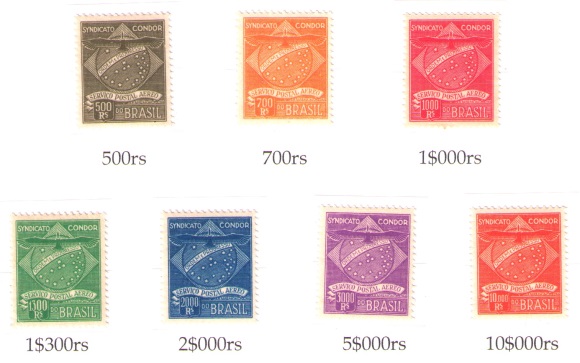
In addition, a 1,300rs stamp, without the "SYNDICATO CONDOR" legend, was produced in two different shades of green, but not officially released.

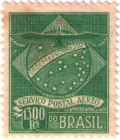
Three years later a change in the rates required new stamps or, in this instance for expediency, overprints of existing stamps. The new rates were applied as follows: Rs.50/700rs; Rs.200/3$000rs; Rs350/10$000rs (a very underused value); and Rs.750/1$300rs--on a stamp which did not bear the "SYNDICATO CONDOR" legend at the top. These were released on 12 September 1930. (I have never understood the use of the four different overprint designs, as, I would presume, the color of the stamp would void any confusion to its new "value.")
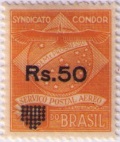
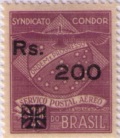


On 16 September 1930, CONDOR opened up a service, with a Junkers F13 land-plane, between Corumbá, a railroad terminus on the Border with Bolivia, and Cuiabá (Cuyabá), 230 kms. farther north in, and capital of, the State of Mato Grosso. This was CONDOR's first inland route and was isolated from their coastal service. By 1933 air service, replacing the railroad, would complete the air connection to São Paulo, but special ground service was needed to Santos (which had no land airport) and CONDOR's coastal seaplane service.

It has been my experience that overprinting (or double-printing, as the U.S. "Jenny") a stamp usually results in "errors," whether inadvertent or contrived. Just as "printer's waste" often surfaces in the marketplace, a few copies of these "errors" are known to exist and are acknowledged by most catalogs. A few are not listed, or the quantities that might have existed are unknown. I show here those that I have in my collection. (The number under the image in parenthesis is the recognized quantity known.)

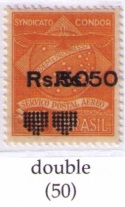


The second air carrier was VARIG (S.A. Empressa de Vição Aerea Rio Grandense) founded in, and initially confined to the State of Rio Grande do Sul, the southernmost state in Brazil. Authorized to operate on 10 June 1927, it also used the required handstamps until its first issue was ready on 9 November 1927. As it had close ties to CONDOR, VARIG chose to use copies of the untitled 1,300 r‚is green stamp, by overprinting, resulting in two values: 700rs (3,950) and the base 1,300rs (15,000). For some reason, another overprint produced a "little" VARIG (Variguinho), 9.5mm high instead of the 12.5mm of the first two, and fewer copies (3,650) were made.


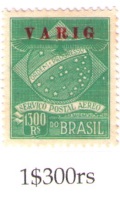
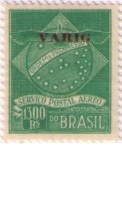
Suffice to say, "here we go again." The overprints found their own locations and which way was "up" and/or, sometimes, up and down.
 On 3 March 1928, VARIG produced Special Delivery (Expresso) and Registration (Registrado) issues by again overprinting, but now the overprinting was done on previously overprinted stamps, in different combinations of value(s) and letter(s). This overprinting continued periodically for the next two years.
On 3 March 1928, VARIG produced Special Delivery (Expresso) and Registration (Registrado) issues by again overprinting, but now the overprinting was done on previously overprinted stamps, in different combinations of value(s) and letter(s). This overprinting continued periodically for the next two years.

On 5 March 1930, after a rate change, overprints were again used in black for the First Zone (up to 500 km.) and in red for the Second Zone (over 500 km.).

Two of the values for the First Zone are known inverted: 350 (50 copies) and 750 (100 copies). It is unusual to find any of these used on an envelope (cover). Ever see an inverted "Jenny" used? For the Second Zone a very strange "error" is known: the "Rs. 1.500" appearing on the same sheet as the "Rs. 1.000" (50 copies), of which only three are known canceled--apparently on purpose.

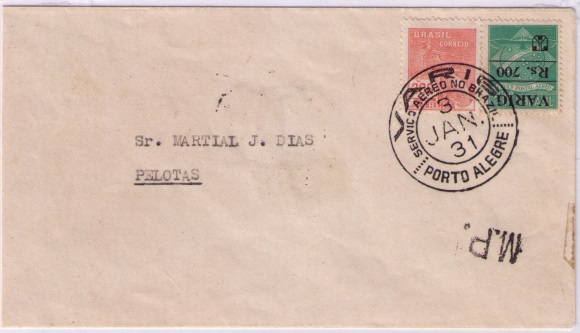
The use of CONDOR stamps was terminated on 30 November 1930, as CONDOR expanded its operations into the international arena. VARIG's stamps were withdrawn from sale on 30 June 1934, as its operations were moving beyond the State borders. Both companies then used government issued air mail stamps.



